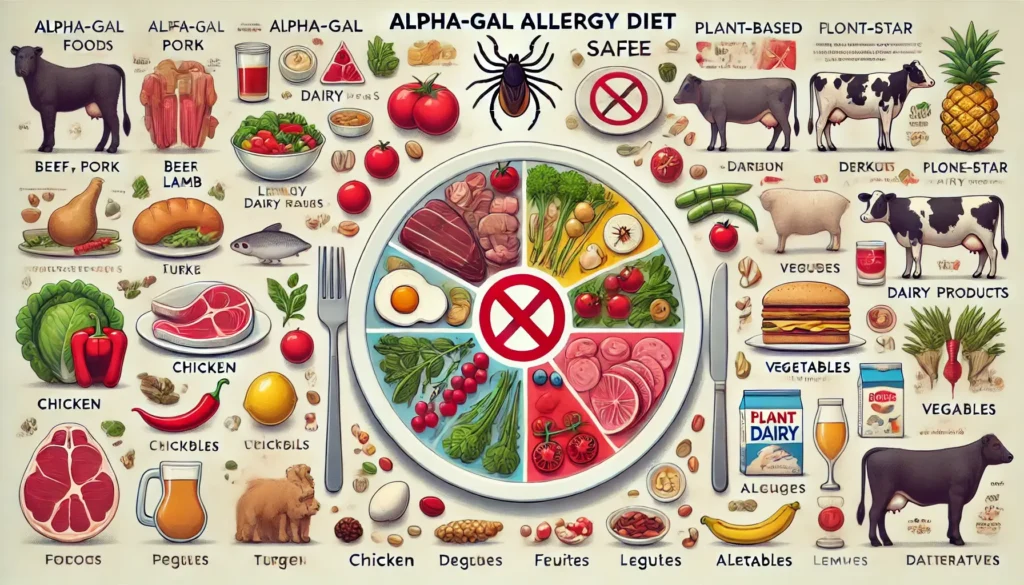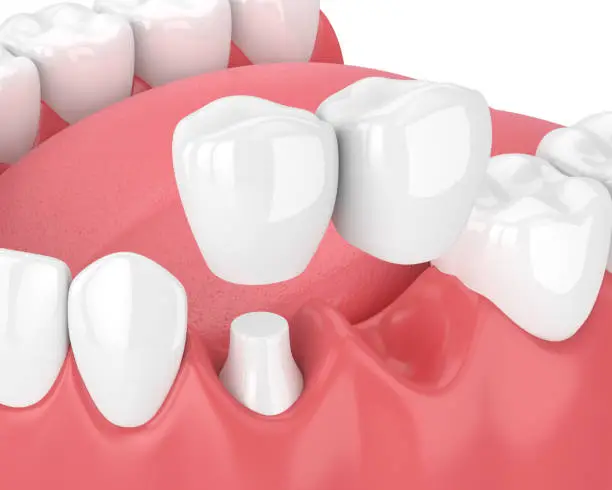Introduction
Alpha-Gal Syndrome (AGS) is a rare and potentially life-threatening food allergy that develops after being bitten by the Lone Star tick. Unlike most food allergies that trigger immediate reactions, Alpha-Gal Syndrome (AGS) is unique because symptoms can appear hours after consuming red meat or products derived from mammals. Managing AGS requires following a strict Alpha Gal Allergy Diet, which eliminates all mammalian products to prevent allergic reactions.
This allergy occurs due to the presence of alpha-gal (galactose-α-1,3-galactose), a sugar molecule found in mammalian products. Once introduced into the body through a tick bite, the immune system can become sensitized, leading to allergic reactions when consuming meat, dairy, or certain medications derived from animals.
Because of the delayed reaction time, many people struggle to identify the trigger, making diet management crucial. This guide will explore everything you need to know about living with Alpha-Gal Syndrome and how to maintain a safe, nutritious diet.

2. Causes and Symptoms of Alpha Gal Allergy Diet
The Lone Star Tick Connection
Alpha-Gal Syndrome is primarily caused by the bite of the Lone Star tick (Amblyomma americanum), which is common in the southeastern and midwestern United States. The tick transmits the alpha-gal sugar into the bloodstream, triggering an immune response that later leads to allergic reactions upon consuming mammalian products.
Common Symptoms of Alpha-Gal Syndrome
Symptoms typically occur 3 to 6 hours after eating red meat or other mammalian-derived foods, making it different from immediate-onset food allergies. Common symptoms include:
- Hives and Skin Reactions (rash, itching, swelling)
- Gastrointestinal Issues (nausea, vomiting, diarrhea)
- Respiratory Symptoms (shortness of breath, wheezing)
- Anaphylaxis (severe, life-threatening allergic reaction)
How It Differs from Other Food Allergies
Unlike peanut or shellfish allergies, which usually cause immediate reactions, Alpha Gal Allergy Diet has a delayed onset. Additionally, it is triggered by a sugar molecule rather than a protein, making it a unique immune response.
3. Diagnosing Alpha-Gal Syndrome
Allergy Testing and Blood Work
If you suspect you have Alpha-Gal Syndrome, an IgE blood test can detect antibodies to alpha-gal. Your doctor may also recommend a skin prick test to confirm the diagnosis.
Elimination Diet and Symptom Tracking
Many doctors advise removing red meat, dairy, and other mammalian products from your diet to see if symptoms improve. Keeping a food diary can help track reactions and identify hidden triggers.
Working with an Allergist
Since AGS is a relatively new condition, working with an experienced allergist is crucial for proper diagnosis and management.
4. Foods to Avoid with Alpha Gal Allergy Diet
To prevent allergic reactions, you must eliminate all sources of alpha-gal from your diet. This includes:
Red Meat
- Beef
- Pork
- Lamb
- Venison
Dairy Products
- Milk, cheese, butter, yogurt
- Ice cream and cream-based sauces
Gelatin and Processed Foods
- Marshmallows, gummy candies
- Broths, soups, gravies
Hidden Sources
- Medications and Supplements (some capsules and IV fluids contain gelatin)
- Personal Care Products (Some lotions and creams contain animal-based ingredients)
Safe Foods and Alternatives
Plant-Based Protein Options
- Beans, lentils, chickpeas
- Tofu, tempeh, and soy-based products
- Nuts and seeds
Poultry and Seafood as Meat Alternatives
- Chicken, turkey, duck
- Fish and shellfish
Dairy-Free Substitutes
- Almond, coconut, oat, or soy milk
- Plant-based cheeses and yogurts
Reading Food Labels and Avoiding Cross-Contamination
When living with Alpha-Gal Syndrome, carefully reading food labels is essential to avoid hidden sources of mammalian products. Many processed foods contain animal-derived ingredients, making cross-contamination a risk.
Hidden Sources of Alpha-Gal in Ingredients
Some ingredients that might indicate the presence of mammalian products include:
- Gelatin (found in candies, marshmallows, and some supplements)
- Casein and Whey (dairy proteins found in protein bars and shakes)
- Lard and Tallow (used in cooking, baking, and processed foods)
- Natural Flavors (may contain animal-derived substances)
Cooking and Preparing Meals Safely
- Use separate cookware and utensils to avoid cross-contamination if others in your household eat red meat.
- Check restaurant menus carefully, and ask about ingredients before ordering.
- Be cautious with fried foods, as they may be cooked in shared oils containing animal fats.
Eating Out with Alpha-Gal Allergy
Dining out can be challenging, but taking the following steps can help:
- To be sure the restaurant can meet your demands, give them a call in advance.
- Ask specific questions about how food is prepared (e.g., “Is this broth made with beef stock?”).
- Stick to simple, unprocessed meals like grilled chicken with vegetables.
Meal Planning for Alpha-Gal Syndrome
Managing Alpha-Gal Syndrome doesn’t mean giving up delicious food. With some adjustments, you can create a satisfying and nutritious meal plan.
Creating a Balanced, Nutrient-Dense Diet
To maintain optimal health, focus on:
- Protein: Chicken, turkey, fish, eggs, tofu, beans
- Healthy Fats: Olive oil, avocado, nuts, seeds
- Fiber: Whole grains, vegetables, fruits, legumes
- Calcium Alternatives: Leafy greens, fortified plant-based milks
Sample Alpha-Gal-Free Meal Plans
Breakfast:
- Oatmeal with almond milk, chia seeds, and berries
- Scrambled eggs with sautéed spinach and whole-grain toast
Lunch:
- Grilled chicken salad with avocado, sunflower seeds, and balsamic dressing
- Quinoa bowl with roasted vegetables and hummus
Dinner:
- Baked salmon with brown rice and steamed asparagus
- Stir-fried tofu with bell peppers, broccoli, and ginger sauce
Quick and Easy Recipe Ideas
- Vegan chili (made with lentils instead of beef)
- Dairy-free smoothies (blend bananas, spinach, and oat milk)
- Homemade veggie burgers (made with black beans and quinoa)

Supplements and Nutritional Considerations
Since eliminating mammalian products can limit some nutrients, it’s important to find safe alternatives.
Ensuring Adequate Protein and Iron Intake
- Protein: Plant-based sources like beans, lentils, nuts, seeds, and tofu
- Iron: Leafy greens, lentils, and iron-fortified cereals (pair with vitamin C for better absorption)
Vitamin B12 and Omega-3 Sources
- B12: Fortified plant-based milk, nutritional yeast, and supplements
- Omega-3s: Flaxseeds, chia seeds, walnuts, and fish (if tolerated)
Probiotics and Gut Health Support
- Probiotic-rich foods like kimchi, sauerkraut, and dairy-free yogurts can help maintain gut health.
Lifestyle Adjustments for Alpha-Gal Allergy
Beyond diet, lifestyle changes can make living with Alpha-Gal Syndrome easier.
Handling Social Situations and Travel
- Always bring safe snacks when attending events or traveling.
- Inform hosts or restaurant staff about your allergy ahead of time.
- Consider using a medical alert bracelet in case of accidental exposure.
Communicating Your Allergy to Friends and Restaurants
- Be clear and firm when explaining your dietary restrictions.
- Ask detailed questions about food preparation to avoid hidden animal ingredients.
Managing Anxiety and Stress Related to Dietary Restrictions
- Educate yourself about safe food options to feel more in control.
- Join support groups to meet people going through similar things.
Future Research and Hope for a Cure
Scientists are actively researching Alpha-Gal Syndrome to develop better treatments and potential cures.
Current Treatments and Management Strategies
- The primary treatment is strict avoidance of mammalian products.
- Antihistamines can help manage mild reactions, while epinephrine (EpiPen) is needed for severe reactions.
Advances in Allergy Research
- Researchers are exploring desensitization therapies to reduce allergic reactions.
- Studies on tick-bite prevention strategies may help reduce new cases.
Potential for Desensitization Therapy
- Some experimental treatments focus on gradual exposure to alpha-gal to retrain the immune system.
11. Conclusion
Living with Alpha-Gal Syndrome requires careful dietary management, but with the right knowledge and strategies, you can maintain a balanced and enjoyable diet. Avoiding red meat, dairy, and hidden sources of alpha-gal is crucial, but there are plenty of delicious and nutritious alternatives available. By reading labels, planning meals, and making lifestyle adjustments, you can successfully manage your allergy while still enjoying a variety of foods.
If you suspect you have Alpha-Gal syndrome, consult an allergist for proper testing and diagnosis. With ongoing research, there is hope for better treatments in the future.
12. FAQs
1. Can Alpha-Gal Allergy Go Away Over Time?
In some cases, the sensitivity to alpha-gal may decrease over time, especially if no further tick bites occur. However, many people must maintain strict diet restrictions indefinitely.
2. Are There Any Medications That Contain Alpha-Gal?
Yes. Some medications, vaccines, and IV fluids contain gelatin or other animal-derived ingredients. Always inform your doctor and check medication ingredients.
3. Can people with Alpha-Gal Eat Chicken and Fish?
Yes! Poultry (chicken, turkey, duck) and seafood do not contain alpha-gal and are safe for most people with Alpha-Gal Syndrome.
4. What Are Some Hidden Sources of Alpha-Gal in Everyday Products?
Beyond food, alpha-gal can be found in cosmetics, lotions, certain medications, and gelatin-based supplements. Always check labels carefully.
5. How Can I Safely Dine Out with Alpha-Gal Allergy?
Call ahead, ask detailed questions about food preparation, and stick to simple, unprocessed meals like grilled chicken or fish with vegetables.



